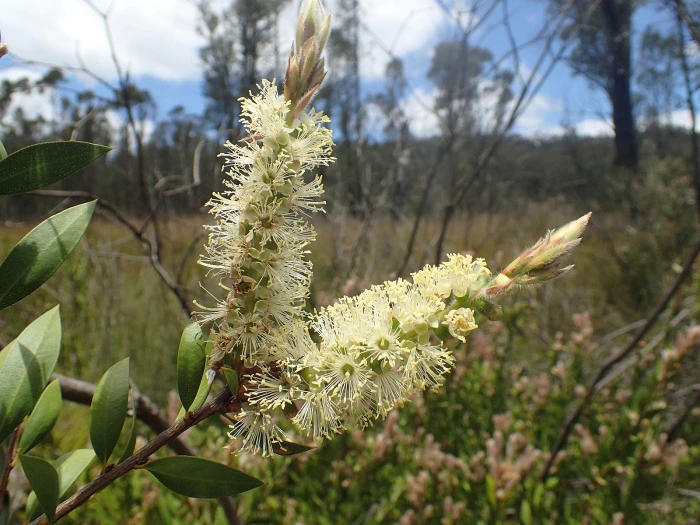Lemon Bottlebrush
(Melaleuca pallida)
Lemon Bottlebrush (Melaleuca pallida)
/
/

Geoff Derrin
CC BY-SA 4.0
Image By:
Geoff Derrin
Recorded By:
Copyright:
CC BY-SA 4.0
Copyright Notice:
Photo by: Geoff Derrin | License Type: CC BY-SA 4.0 | License URL: https://creativecommons.org/licenses/by-sa/2.0 | Uploader: Gderrin | Publisher: Wikimedia Commons |

















Estimated Native Range
Climate Requirements for Boston, Massachusetts
| This Plant | Your Site | Plant Suitability for Your Location | ||
|---|---|---|---|---|
| • Precipitation | 17" - 101" | 45" | Aquatic | Aquatic |
| • High Temp. | 60°F - 90°F | 84°F | Your summer temperatures are normal for this plant. | Excellent |
| • Low Temp. | 3°F - 49°F | 18°F | Your winter temperatures are normal for this plant | Excellent |
This plant may not grow well at your location - your precipitation is too high.
Summary
Melaleuca pallida, commonly known as Lemon Bottlebrush, is a perennial shrub native to the coastal swamps and wet woodlands of eastern Australia and Tasmania. It typically reaches up to 8 meters (30 feet) in height and is characterized by its thin, spreading branches and fibrous or papery bark. The foliage often has a silvery sheen due to its new growth. The pale yellow to cream, and occasionally pinkish-red bottlebrush flowers are showy and appear in spikes at the ends of branches. Flowering occurs from spring to summer (October to February in the Southern Hemisphere), and the plant produces distinctive woody, cup-shaped capsules as fruit.
Lemon Bottlebrush is valued for its unique flowers and ability to attract pollinators such as bees and birds. It is used in cultivation for ornamental purposes, often in urban landscapes, as a feature or screening plant, and in areas requiring plants that can tolerate wet conditions. This shrub is relatively easy to maintain, requiring medium water and thriving in full sun to part shade. It prefers soils with medium drainage and can tolerate a range of soil types, including clay and sandy soils. While generally disease-resistant, it can be susceptible to root rot if overwatered or planted in poorly drained soils. Lemon Bottlebrush is not known for aggressive roots or significant disease problems, making it a reliable choice for gardeners.CC BY-SA 4.0
Lemon Bottlebrush is valued for its unique flowers and ability to attract pollinators such as bees and birds. It is used in cultivation for ornamental purposes, often in urban landscapes, as a feature or screening plant, and in areas requiring plants that can tolerate wet conditions. This shrub is relatively easy to maintain, requiring medium water and thriving in full sun to part shade. It prefers soils with medium drainage and can tolerate a range of soil types, including clay and sandy soils. While generally disease-resistant, it can be susceptible to root rot if overwatered or planted in poorly drained soils. Lemon Bottlebrush is not known for aggressive roots or significant disease problems, making it a reliable choice for gardeners.CC BY-SA 4.0
Plant Description
- Plant Type: Tree, Shrub
- Height: 3-5 feet
- Width: 3-10 feet
- Growth Rate: Moderate
- Flower Color: Yellow, Cream
- Flowering Season: Spring, Summer
- Leaf Retention: Evergreen
Growth Requirements
- Sun: Full Sun, Part Shade
- Water: Medium
- Drainage: Medium
Common Uses
Bee Garden, Bird Garden, Butterfly Garden, Deer Resistant, Drought Tolerant, Fragrant, Hedges, Hummingbird Garden, Low Maintenance, Salt Tolerant
Natural Habitat
native to the coastal swamps and wet woodlands of eastern Australia and Tasmania
Other Names
Common Names:
Scientific Names: Callistemon pallidus, Melaleuca pallida, Metrosideros pallida
GBIF Accepted Name: Melaleuca pallida (Bonpl.) Craven